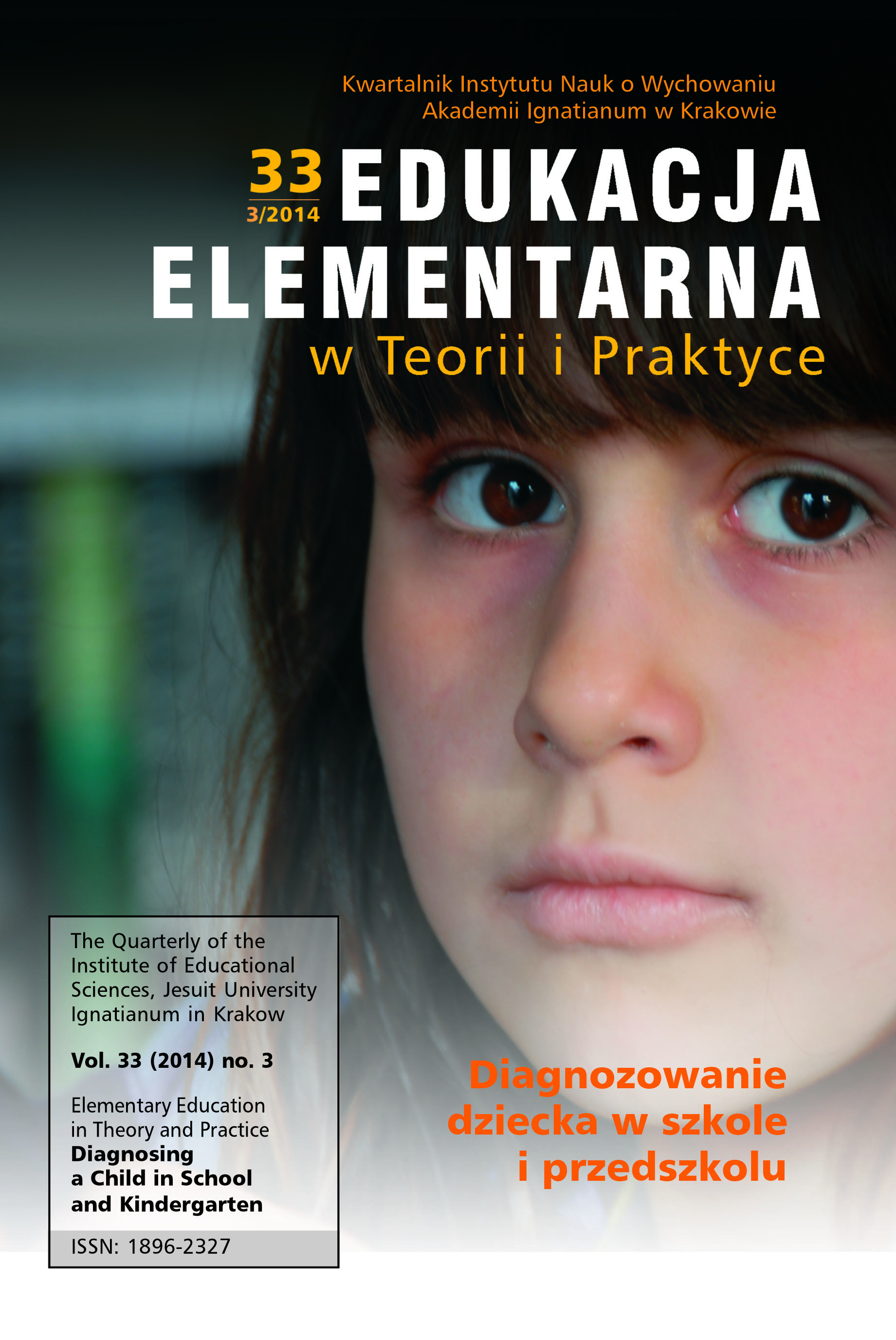Wywiad z rodzicami jako istotny element diagnozy logopedycznej dzieci w wieku przedszkolnym
Abstrakt
Diagnoza logopedyczna jest procesem złożonym. Powinna być rzetelna i pogłębiana w czasie trwania całej terapii logopedycznej. Jej istotą jest rozpoznanie danego zjawiska logopedycznego. W celu dokonania diagnozy logopeda musi podjąć różne działania. Poprzedzać ją powinien wywiad przeprowadzony z rodzicami (opiekunami) dziecka. Powinien on odbywać się w przyjemnej atmosferze i bez pośpiechu. Rodzic lub opiekun dziecka powinien odczuć ze strony logopedy duże zainteresowanie swoim problemem. Wywiad umożliwia logopedzie zdobycie cennych informacji o badanym dziecku i pomaga w stawianiu odpowiedniej diagnozy logopedycznej. W artykule poddano szczegółowej charakterystyce jedno z narzędzi logopedycznych, jakim jest kwestionariusz wywiadu. Powinien on zawierać między innymi pytania dotyczące sytuacji rodzinnej dziecka, jego rozwoju fizycznego i psychicznego, w tym również pytania dotyczące przebiegu ciąży, chorób w tym okresie, przyjmowania leków podczas ciąży, przebiegu porodu. W artykule zwrócono uwagę na korzyści wynikające z przeprowadzenia wywiadu. Dobrze przeprowadzony wywiad pozwala logopedzie nie tylko na poznanie właściwości rozwoju psychofizycznego dziecka, ale umożliwia również uchwycenie czynników warunkujących ten rozwój. Dokładna analiza informacji uzyskanych od rodziców czy opiekunów dziecka, może się również przyczynić do określenia przyczyn zaburzeń mowy. W artykule zaprezentowano wybrane wyniki badań dotyczące rozwoju mowy oraz rozwoju ruchowego u dzieci w wieku przedszkolnym. Informacje na temat tych aspektów rozwojowych uzyskano od rodziców dzieci objętych badaniem logopedycznym.Bibliografia
Dilling-Ostrowska E., Rozwój i zaburzenia mowy u dzieci w zależności od stopnia dojrzałości układu nerwowego, [w:] Zaburzenia mowy u dzieci, red. J. Szumska, PZWL, Warszawa 1982, s. 19.
Dutkiewicz W., Podstawy metodologii badań do pracy magisterskiej i licencjackiej z pedagogiki, Wydawnictwo Stachurski, Kielce 2001.
Jastrzębowska G., Pelc-Pękala O., Metodyka ogólna diagnozy i terapii logopedycznej, [w:] Pytania i odpowiedzi. Podręcznik akademicki, red. T. Gałkowski i G. Jastrzębowska, Wydawnictwo Uniwersytetu Opolskiego, Opole 1999, s. 633–638.
Minczakiewicz E.M., Logopedia. Mowa, rozwój, zaburzenia, terapia, Wydawnictwo Naukowe WSP, Kraków 1997.
Minczakiewicz E.M., Początki i rozwój polskiej logopedii, Wydawnictwo Edukacyjne, Kraków 1998.
Pilch T., Bauman T., Zasady badań pedagogicznych. Strategie ilościowe i jakościowe, Wydawnictwo Akademickie „Żak”, Warszawa 2001.
Skorek E.M., Z logopedią na ty. Podręczny słownik logopedyczny, Oficyna Wydawnicza „Impuls”, Kraków 2000.
Surma B., Diagnozowanie rozwoju dzieci w wieku przedszkolnym, [w:] Podstawy pedagogiki przedszkolnej, red. J. Karbowniczek, M. Kwaśniewska, B. Surma, Wydawnictwo WAM, Kraków 2013, s. 329.
Copyright (c) 2014 Edukacja Elementarna w Teorii i Praktyce

Utwór dostępny jest na licencji Creative Commons Uznanie autorstwa – Bez utworów zależnych 4.0 Międzynarodowe.
1. Autor zgłaszając swój artykuł oświadcza, że jest Autorem artykułu (zwanego dalej Utworem) i:
- przysługują mu wyłączne i nieograniczone prawa autorskie do Utworu,
- jest uprawniony/a do rozporządzania prawami autorskimi do Utworu.
Oświadcza, że nie narusza praw autorskich osób trzecich i praw prawnych.
Oświadcza, że nie występuje żaden konflikt interesów.
2. Udziela Uniwersytetowi Ignatianum w Krakowie nieodpłatnej, niewyłącznej, nieograniczonej terytorialnie licencji do korzystania z Utworu na następujących polach eksploatacji:
- utrwalania utworu w formie papierowej, a także na nośniku cyfrowym lub magnetycznym;
- zwielokrotnienia utworu dowolną techniką, bez ograniczenia ilości wydań i liczby egzemplarzy;
- rozpowszechniania utworu i jego zwielokrotnionych egzemplarzy na jakimkolwiek nośniku, w tym wprowadzenia do obrotu, sprzedaży, użyczenia, najmu;
- wprowadzenia utworu do pamięci komputera;
- rozpowszechniania utworu w sieciach informatycznych, w tym w sieci Internet;
- publicznego wykonania, wystawienia, wyświetlenia, odtworzenia oraz nadawania i reemitowania, a także publicznego udostępniania utworu w taki sposób, aby każdy mógł mieć do niego dostęp w miejscu i czasie przez siebie wybranym;
- w zakresie praw zależnych do Utworu, obejmujących w szczególności prawo do dokonania koniecznych zmian w Utworze, wynikających z opracowania redakcyjnego i metodycznego, a także do dokonania tłumaczenia Utworu na języki obce.
Udzielenie licencji następuje z chwilą przekazania Utworu na rzecz Uniwersytetowi Ignatianum w Krakowie. Uniwersytet Ignatianum w Krakowie jest uprawniony do udzielania dalszych sublicencji do Utworu, w zakresie udzielonego prawa. Licencja jest ograniczona czasowo i zostaje udzielona na okres 15 lat, licząc od daty jej udzielenia.
Wyraża się zgodę i zachęca autorów do publikacji ich tekstu w Internecie (np. w repozytorium instytucji lub na jej stronie internetowej) przed lub podczas procesu składania tekstu jako, że może to prowadzić do korzystnych wymian oraz wcześniejszego i większego cytowania opublikowanego tekstu (Patrz The Effect of Open Access). Zalecamy wykorzystanie dowolnego portalu stowarzyszeń badawczych z niżej wymienionych:




